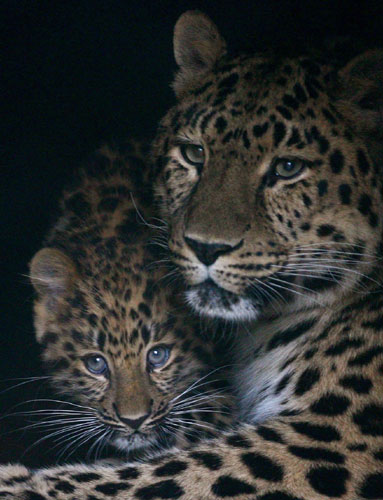Rarest leopard making comeback
Updated: 2012-04-20 08:02
By Wu Yong and Liu Ce in Shenyang and Han Junhong in Changchun (China Daily)
|
||||||||
The population of the Amur leopard, the rarest cat in the world, is showing signs of recovery, according to a report from the forestry department in Jilin province and the World Wide Fund For Nature.
 |
|
A female Amur leopard and its cub. [Photo/China Daily] |
"Thanks to (China's) enormous efforts to protect forests and crack down on poaching, the big cat appears to be rebounding in China," said Jiang Jinsong, an official from Jilin provincial forestry department.
Earlier this year, the department, jointly with the WWF and Wildlife Conservation Society, performed an Amur leopard survey in the province's Changbai Mountain area. The goal of the investigation was to confirm the big cat's habitat and population and make preparations for further protection.
The survey, which covers around 2,000 square kilometers, indicated that six female leopards, two male leopards and one cub are living in Northeast China's Jilin province, home to one-fourth of the world's Amur leopard population. It also identified 12 of the leopard's important habitats.
The leopard's habitat has expanded and is now three to four times larger than it was in the late 1990s.
"That's really a surprise, which indicates our efforts have paid off," said Jiang Guangshun, a senior official with the WWF who has studied the wild leopard and Siberian tiger for 20 years.
"The settlement of female leopards is the key indicator to evaluate how healthy the population is," he said.
China has intensified the preservation of virgin forests and protection of wildlife in the past decade. In 2001, it set up the Hunchun nature reserve for wild Siberian tigers and leopards. The reserve is located in the border area between China, Russia and the Democratic People's Republic of Korea.
According to the report released by the Jilin forestry department, applied research, habitat protection, effective law enforcement and the support of local people all contributed to leopard's survival.
"The most important work is to restore the food chain of leopards," said Lang Jianmin, an official from Hunchun nature reserve.
He noted that Amur leopards, which can weigh up to 90 kilograms at maturity, travel great distances in search of prey such as elk and wild boar.
In the early 20th century, human settlements, habitat loss and poaching drove the cats near extinction.
"It is an uphill battle, but one worth fighting. The leopards' situation has shown improvement. We can say all these efforts have paid off," said Jiang Jinsong from the Jilin forestry department.
Contact the writers at wuyong@chinadaily.com.cn, liuce@chinadaily.com.cn and hanjunhong@chinadaily.com.cn

 Relief reaches isolated village
Relief reaches isolated village
 Rainfall poses new threats to quake-hit region
Rainfall poses new threats to quake-hit region
 Funerals begin for Boston bombing victims
Funerals begin for Boston bombing victims
 Quake takeaway from China's Air Force
Quake takeaway from China's Air Force
 Obama celebrates young inventors at science fair
Obama celebrates young inventors at science fair
 Earth Day marked around the world
Earth Day marked around the world
 Volunteer team helping students find sense of normalcy
Volunteer team helping students find sense of normalcy
 Ethnic groups quick to join rescue efforts
Ethnic groups quick to join rescue efforts
Most Viewed
Editor's Picks

|

|

|

|

|

|
Today's Top News
Health new priority for quake zone
Xi meets US top military officer
Japan's boats driven out of Diaoyu
China mulls online shopping legislation
Bird flu death toll rises to 22
Putin appoints new ambassador to China
Japanese ships blocked from Diaoyu Islands
Inspired by Guan, more Chinese pick up golf
US Weekly

|

|






